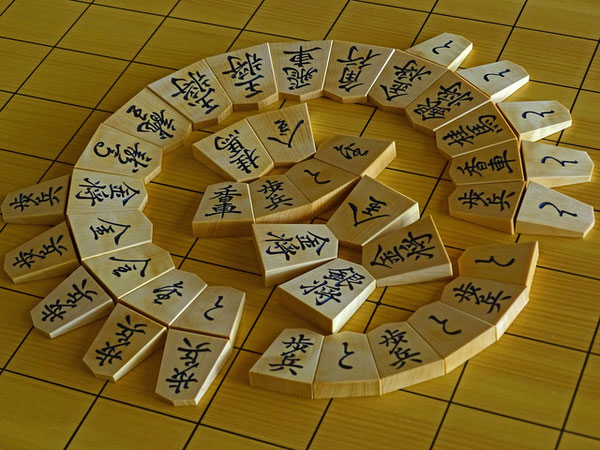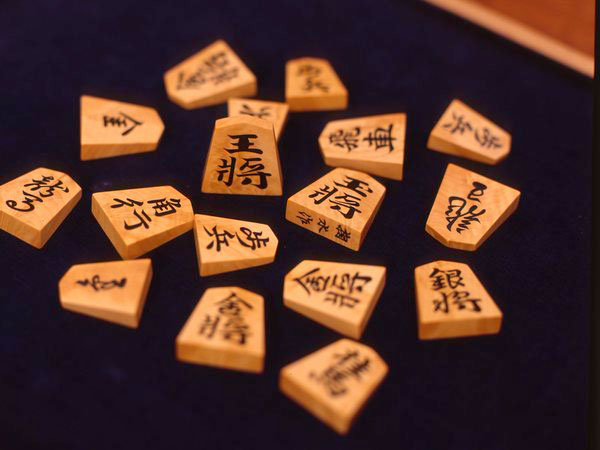
- Other crafts
- Yamagata
Tendo Japanese chess pieces Tendo shogi koma
Beautiful wood grain and glossy black lacquer
The expression of the Japanese sense of beauty
Description
What is Tendo Japanese chess pieces ?
Tendo Japanese chess pieces (called Tendo shogi koma in Japanese) are made in the cities of Tendo, Yamagata, and Murayama in Yamagata prefecture. Production is thought to have begun in Tendo back during the Edo period (1603-1868) and now the city makes up almost all of the national output.
This craft features a glossy black color and lively kanji characters (Chinese-derived characters) written in Japanese lacquer. The original style of Tendo chess piece is kakigoma, with cursive font kanji characters written directly on a wood surface with lacquer. The writing of kanji in a square font style began after World War II and approximately one hundred fifty or so font styles are in use today. Besides the kakigoma style which now has fairly limited production, engraved styles have become increasingly popular. The horigoma style has kanji characters engraved and lacquered while the moriagegoma style uses additional urushi to slightly raise the kanji character above the surface of the piece. Kakigoma, Horigoma, Horiumegoma, and Moriagegoma have each been designated as National Traditional Crafts in 1996.
The variety of natural wood types and their beautiful grains contribute greatly to the fascination of Tendo chess pieces. Magnolia, hakusanbou, boxtree, and painted maple are all important wood materials with the finest being boxtree from Mikurajima Island of the Izu Islands, which are south of Tokyo. The beauty of the grain is reflected in the product price with full sets of forty shogi pieces with matching grain and colors costing a high amount.
History

Shogi is a Japanese board game resembling chess thought to have originated in India and been imported to Japan in the Nara period (710-784). Scholars believe that shogi piece production came about at the end of the Azuchi-Momoyama period (1568-1600) with the development of the kakigoma style using black lacquer.
Japanese chess pieces began to be made in Tendo in the late Edo period, when the game was already popular among the general populace. At the time the Tendo domain (modern day city of Tendo) was suffering from financial difficulties and to restore the economy, local people learned how to make chess pieces from the neighboring Yonezawa domain (now city of Yamagata), and established the kakigoma cursive font style. When chess piece production in Tendo became a full-fledged industry, former samurai became woodworkers or kanji character artisans, collaborating to help further development. In a short amount of time, the city of Tendo became famous throughout the country as the mass production area of shogi pieces. During the Taisho era (1912-1926), production became mechanized and grew so much that even children helped to write characters on pieces. The oshigoma style (chess pieces with stamped kanji characters) was introduced in the early Showa era (1926-1989), and Tendo overtook the city of Osaka to have the number one chess piece production in the country. The production of oshigoma and kakigoma peaked in 1955 and then declined as the engraved horigoma style became more popular. From around 1965, research and development of exclusive products such as horiumegoma and moriagegoma began.
General Production Process

- 1. Rough cutting
Specially selected logs are thoroughly dried for a few years to prevent any later cracking or distortion. The log is sliced into rounds at about the thickness of a chess piece. The wood slices are cut roughly along the grain. Among the types of wood, boxwood is considered to be the best, as it has a beautiful grain, moderate hardness, and the strength for years of use. Especially priced and reserved for top quality pieces are Japanese boxtree from Mikurajima Island near Tokyo and the town of Satsuma in Kagoshima prefecture.
- 2. Cutting
A komagirinata or small hatchet is used to shave the wood and cut it into small pieces, then both sides are whittled down to the width of the chess pieces. The underside is flattened, and then the top shaved to make the piece's unique shape. The next process is to cut the wood to make forty chess pieces of the right width with a similar grain picked out and cut into an irregular pentagon shape. Since the beauty of the grain is fairly important, the pieces must be selected with the artisan's attentive eye.
- 3. Pasting calligraphy, carving
Next is a process to paste paper with a written kanji character onto each chess piece. After pasting, the piece is fastened to special table and the characters are engraved with a knife. Highly-skilled engravers use another technique called sukashibori, which is to directly carve wood without pasting any paper. In the lacquering groundwork process, a coat of natural glue or persimmon tannin is applied to the engraved characters. In recent years, this is substituted with a form of glue.
- 4. Lacquering
Chess pieces with engraved characters coated with Japanese lacquer are known as horigoma and are both hand-carved and machine-carved products. Horiumegoma is made by repeatedly painting the engraved characters with rust lacquer and allowing each layer to dry which can take almost a month until the lacquer reaches the level of the wood. In the next process, the surface of the chess pieces is intensively polished. The last step of horiumegoma is polishing the surface with a piece of porcelain.
- 5. Moriagegoma
Moriagegoma is a piece with characters written in raised lacquer. After horiumegoma is complete, each kanji character's surface is raised by adding several layers of Japanese lacquer with a brush. Since it is impossible to apply a thick coat of lacquer at one time, repeated lacquering and drying is required. Moriagegoma is a highly exclusive product, even used in professional chess games. Only the very best artisans can lacquer evenly and three-dimensionally.
- 6. Kakigoma
Then the kanji characters are directly written in black lacquer on a wood surface. Seems simple, but writing with sticky lacquer on such a tiny chess piece requires lots of skill. Master artisans with decades of experience make it look deceptively simple, taking only a few flicks of the brush to produce beautiful and much admired calligraphy in a matter of moments. There are two kinds of characters, a cursive font, which is the most traditional design in Tendo and square font.
Where to Buy & More Information
Tendo Shogi Shiryokan
-
Address
-
Tel.+81-23-653-1690
-
Closed3rd Mondays (open if Monday is holiday and closed the next day) and December 29 to January 3
-
Business Hours9am to 6pm
-
Website
See more Other crafts
- Edo kiriko cut glass
- Koshu lacquered deer leather
- Kyo folding fans
- Marugame uchiwa fans
- Boshu uchiwa fans
- Gifu lanterns
- Yamaga lanterns
- Kyo uchiwa fans
- Tendo Japanese chess pieces
- Edo glass
- Edo patterned paper
- Yame lanterns
- Owari Cloisonné
- Fukuyama Koto (Japanese Harp)
- Kyo art preservation
- Banshu fly-fishing flies
- Woodblock prints
- Koshu hand-carved seals
- Edo Hyogu (Art Mountings)
- Edo tortoise shell crafts
- Etchu Fukuoka Sedge Hats
- Gifu Japanese Umbrellas
- Nagasaki tortoise shell crafts
- Nagoya Sekku Kazari
- Sanshin
- Tokyo Koto (Japanese Harp)
- Tokyo Shamisen































































































































































































































































































